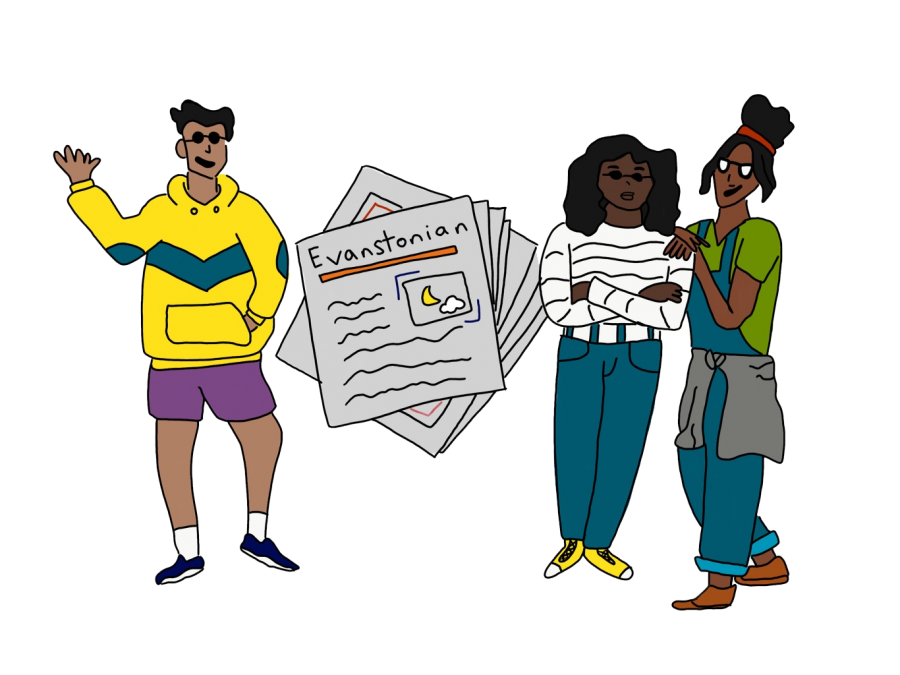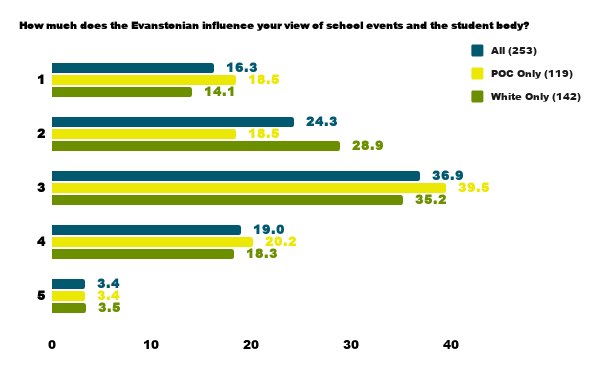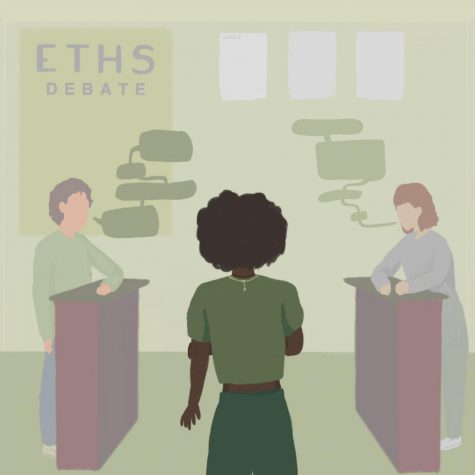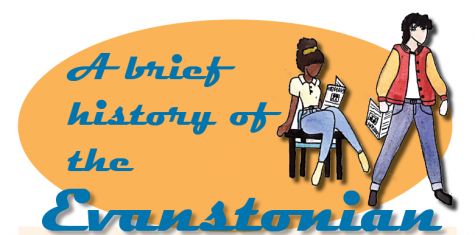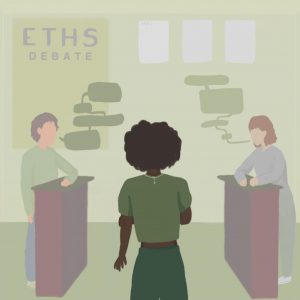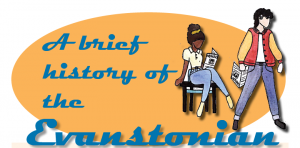The Evanstonian viewed as ____, ______ by the student body
February 22, 2021
The Evanstonian is composed of writers and artists who commit their time and effort to write articles that cover topics relating to Evanston and students at ETHS. While the Evanstonian has had many groundbreaking accomplishments over its 104-year history, it has yet to include and represent more BIPOC students and have a staff that looks like the school’s population and provides coverage that fully captures the diversity of experiences and stories that exist at ETHS. To better understand these elements, this piece delves into how effectively the paper covers Evanston and ETHS with regards to race and ethnicity.
In the “Equity within the Evanstonian” survey, created by the Evanstonian, the newspaper received 263 responses from students and asked them for feedback and ideas for how the paper could be a more racially equitable publication. Unsurprisingly, 54.0 percent (142) of respondents were white students, while only 24.8 percent (66) and 10.7 percent (28) of responses were from Black or Latinx students, inclusive of students who identify as mixed race, respectively. While the percentage of Black students that responded to the survey was close to the Black student population at ETHS (24.8 percent of respondents were Black while 26 percent of the overall student population is Black), the number of Latinx students was almost eight percent lower on the survey than for the overall school population (10.7 percent versus 18 percent). In total, the survey responses were 45.2 percent (119) students of color and 54.0 percent (142) students who only identify as white; this is contrasted to the overall student population, which is 54 percent students of color and 46 percent white.
Furthermore, almost half of the responses were freshmen, 48.9 percent (128), while grades 10-12 had less than 20 percent individually. Since the survey focused on equity, it was important that the Evanstonian looked for Black and brown voices. Ultimately, the survey results didn’t accurately represent the student population in terms of racial demographics. The data was a telling sign that the students involved in the Evanstonian have a disproportionate number of white students in their circles who were willing to respond to the survey, as opposed to reaching the goal of making said survey demographically representative of the entire school population.
The survey consisted of questions that allowed students to rate the Evanstonian’s relationship with the student body in addition to one open-ended response question.
The majority of students, 40.7 percent (107), responded with a one or two versus the 22.4 percent (59) who put a four or five, meaning that more people believe the Evanstonian has little influence on how people view the student body and school events than those that do believe the paper has a large impact. It was also found that more POC students, 28.6 percent (34), did not believe that they were a part of the Evanstonian’s intended audience as opposed to the number of white students, 16.2 percent (23), that did not believe they were a part of the Evanstonian’s intended audience. Additionally, 52.8 percent (75) of white students chose a four or five, meaning that they felt the newspaper was meant to appeal to them while only 36.1 percent (43) that were POC responded with a four or five.
A common theme in the responses was freshmen not reading the Evanstonian as much as upperclassmen. Since 48.7 percent who responded were freshmen, the overwhelming majority of students selected 1, 58.8 percent (155), while only 2.3 percent (6) of students chose a 5 in terms of reading frequency. Adding the fact that the majority of respondents were white, it was difficult to find students of color who read the Evanstonian so they could give their thoughts on how to be more equitable.
49.2 percent (128) of students selected a 3 regarding the Evanstonian’s representation of the experiences of the entire ETHS student body, indicating almost half of the respondents believed the paper does an average job representing the experiences of the student body. 29.6 percent (77) selected either a 4 or a 5, indicating that many students thought the Evanstonian does a fair job of representing the experiences of the entire ETHS student body. From that percentage, 28 (36.4 percent) of respondents were students of color compared to the 49 (63.6 percent) white respondents. On the other hand, 21.2 percent selected either a 1 or a 2. From this, 39 (70 percent) of the respondents identified as students of color whereas only 15 (27.3 percent) of the respondents identified as white. This suggests a divide in terms of how well students believed the paper represented the experiences of the entire ETHS student body by race, with white students seeing themselves represented more in coverage more than respondents of color did.
The last scale type question asked students whether or not they believed the Evanstonian has tokenized their racial identity. 43.1 percent (110) of students selected 1, indicating that they didn’t believe the Evanstonian had tokenized their racial identity. This mainly had to do with the number of white students who responded, 54.1 percent (138), compared to the 45.1 percent (115) of responses who identified as students of color. 10.6 percent (27) of students responded with 4 or 5, meaning they believed the Evanstonian has tokenized their racial identity frequently. The majority of these responses came from students of color of which 18.3 percent (21) believed they had been tokenized compared to the 4.3 percent (6) white students who put a 4 or 5.
In addition to the scale questions, students could enter a written response when asked how the Evanstonian can become a more equitable publication.
Based on responses and interviews from students and staff, this article reflects on how to improve the newsroom’s coverage. This article will be examining the aspects that the Evanstonian lacks, such as diversity and how to talk about complex topics by looking at how the ETHS student body perceives the paper.
Diversifying voices in our writers and interviews
Currently, according to the survey, the Evanstonian has not been representative of the entire ETHS student population both in terms of writers as well as the people who are interviewed.
“I haven’t paid much attention to this, but I do think [the Evanstonian] should be something that people are looking at in terms of who’s getting interviewed and what students are getting interviewed or featured,” chemistry teacher Tina Lulla said. “Are they reflective of our schools’ population? Or does it end up being like, whoever the Evanstonian staff knows because they have to get it done and then they reach out to whoever they can?”
Lulla later added she had seen that some of her students in the past were constantly being interviewed and featured by the Evanstonian. At first, she was confused and wondered what the student’s relationship was with the Evanstonian. Turns out, the students’ friend was an editor, and that’s why they were constantly being interviewed.
It’s essential to welcome voices from all backgrounds and change up the voices so people hear more stories to better represent the school.
“I just wonder how the paper speaks to kids of various socio-economic backgrounds along the lines of race. Maybe intentionally trying to go into spaces where students that are not reflected in the paper are in. Maybe it’s going to lunch, or maybe it’s going to the summits. It’s an intentional approach at trying to get that voice and needing that voice,” history and economics teacher Alex Brown explains.
According to the survey, more than half of students thought the Evanstonian to be a misrepresentation of the entire ETHS student body.
“Go into BIPOC/queer/immigrant/disabled/marginalized spaces and tell them that their stories matter and their voices are welcome, but, at the same time, emphasizing that they have no obligation to speak up if they don’t want to,” a South Asian senior explains.
Other students reinforced the same idea of welcoming more voices of people who want to be included.
“I think just reaching out to all communities and classrooms at ETHS and letting it be known that you truly welcome everyone to you. I feel like a lot of kids just aren’t really aware of that and feel as though it’s a totally different environment from theirs,” a Latinx and white junior says.
The Evanstonian is a predominantly white organization, and the lack of students of color involved prevents inclusivity and representation of the ETHS community. This can lead to a repetition of topics, perspectives and opinions.
This begs a question: How can the Evanstonian diversify its interviews? How can student journalists reach out to the various communities inside and outside ETHS?
Go into BIPOC/ queer/ immigrant/ disabled/ marginalized spaces and tell them that their stories matter and their voices are welcome, but, at the same time, emphasizing that they have no obligation to speak up if they don’t want to.
— South Asian Senior
One way the Evanstonian can include this practice is by stressing the importance of reaching out to students of color to join.
“I think ensuring or working towards a diverse staff,” Lulla says. “With a particular focus on making sure our Black student voices are heard and our voices are heard.”
History teacher Ganae McAlpin explains how the Evanstonian can emphasize the voices of Black and brown students.
“Training Black and brown students to be leaders, recruiting more Black and brown folks to [write and] co-write pieces,” McAlpin says.
The idea of reviving guest writing is another method the Evanstonian can utilize as means to branch out to gain diverse writers.
“I think it would be so cool if we [students who don’t write for the newspaper] could submit pieces from our classes. Include more guest opinion writers to submit things to the paper to get published,” McAlpin explains.
Broadening subject matter to reach more communities within ETHS
Whether it’s class, politics, identity or socially related issues, writing about complex topics is a challenging process. Topics like these deal with applying one’s own positionality to craft their story. In the survey, a student noted that the Evanstonian repeats a pattern of reporting the same viewpoints in its articles.
“Every piece comes from the same perspective, especially regarding current events and political topics. Maybe get more writers from different sides of the political spectrum to get more variety in opinions,” a Black junior explains.
Brown expands on this idea by questioning the intended audience of Evanstonian pieces.
“One [idea] might be to just write articles that are more geared towards what one would perceive the audience that they’re trying to attract. ETHS has always done a really good job of being a school that met the needs of white students for sure, and middle and upper-class students,” Brown explains. “ETHS has never done a great job, and still doesn’t do a great job of—not because any malicious intent—extending the benefits and extending the light on being intentional about bringing in the voices of students that are less well-to-do. That disproportionately, at least in Evanston, happens to be students of color.”
The Evanstonian is known to be a progressive, liberal publication. Its viewpoints reflect the political and social climate of Evanston. Understandably, it may be difficult for a writer who wants to explore a complex or differing viewpoint to express their voice. However, the Evanstonian shouldn’t limit or prohibit those people. Including voices of those who vary on the political spectrum will allow the Evanstonian to see variability in opinions and vocalization.
One of the other moves that the publication can take is to actively work to decenter white voices.
When asked how the paper could be a more equitable publication, a white freshman responded by writing, “By not listening to me. Listen and take advice from POC, not the people who have always profited from this kind of news coverage.” According to a white senior in the survey, they said, “There should be a more diverse group of writers. Only people with adequate writing skills and/or a deep personal connection to the content should tackle controversial issues, especially racial issues.” That idea is reinforced by another response. In the survey, a black freshman says that the Evanstonian should “talk about other problems going on with other races like Muslims, and Indigenous people.”
The Evanstonian can become a more equitable publication by attempting to re- cruit people from a variety of backgrounds instead of waiting for people to come to them.
— Black, multiracial freshman
In the media, Asians and Indigenous people are often overlooked during discussions of racial issues, especially when compared to reporting on the other two major racial minority groups: Latinx and Black communities.
According to a response, a Black sophomore stated, “The Evanstonian can become more equitable by talking about more tough topics, and maybe have a debate or question poll.”
Finding creative, engaging ways to talk about hard topics is a great way to establish a foundation that will eventually allow students to write about those issues.
Where does the Evanstonian go from here?
Based on the responses, the Evanstonian has failed to represent the entire student body and include people from all backgrounds—from its staff to those who are interviewed for articles to the stories that are shared within the publication.
“The paper is not reflective of the student body in terms of its racial makeup,” Brown explains.
Moving ahead, the Evanstonian will acknowledge its failures so the publication can become a paper where all students are heard and one that students will feel proud to read.
“It has been the students and the sponsors who have really been having some courageous conversations to really figure out, ‘Okay, has this really been traditionally a space where students of color have felt, seen, heard or where they felt like they belong?” says Assistant Superintendent and Principal Marcus Campbell. “I have had a number of conversations with staff members who sponsor various prestigious institutions of ETHS to reflect more of the student body. I think that the Evanstonian too has been a part of the conversation. It’s been a part of their journey, and I’ve seen some great strides. And, of course, there’s still a lot of work to be done.”


